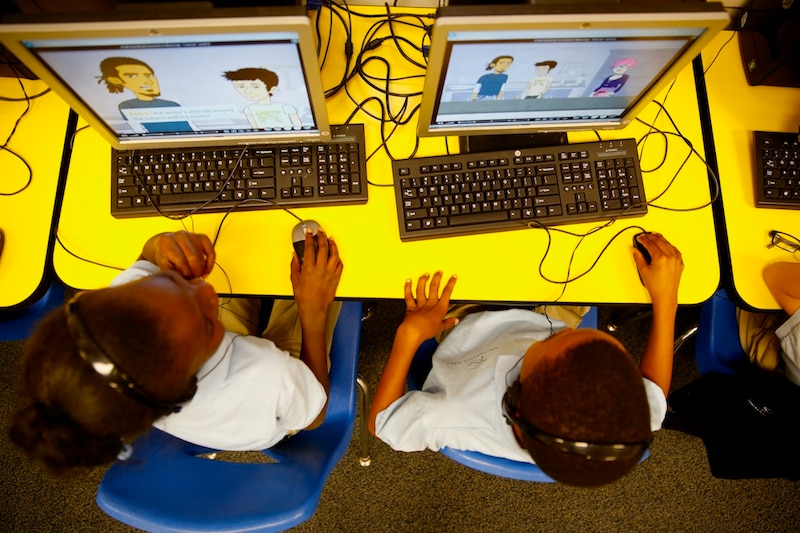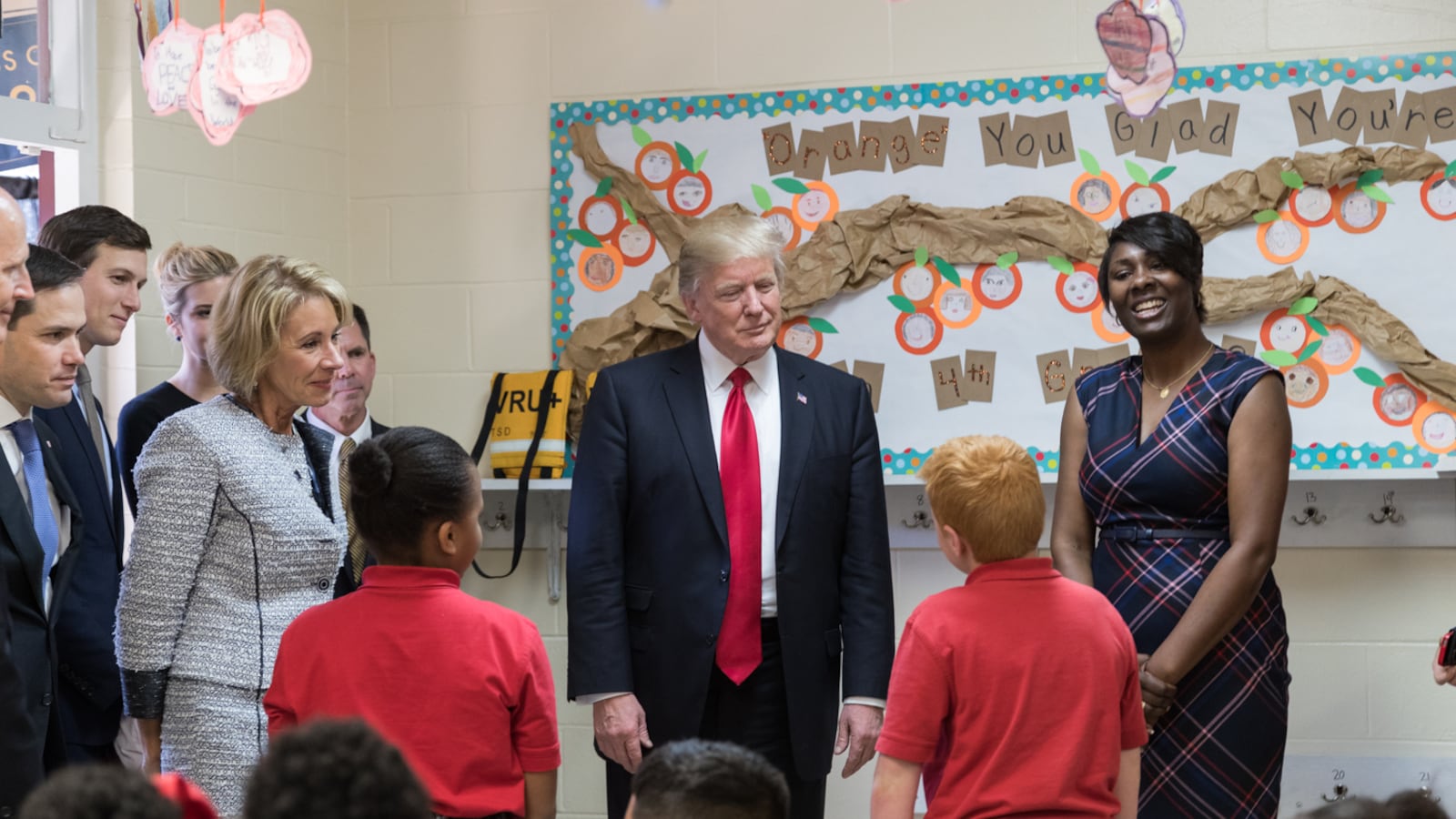Debates over “school choice” — or “privatization” to critics — were already heated.
Then came a rhetorical hand grenade: a report by the Center For American Progress describing the “racist origins” of school vouchers and presented at the American Federation of Teachers headquarters. AFT president Randi Weingarten doubled down in a recent speech, arguing that voucher programs are the “only slightly more polite cousins of segregation.”
Unsurprisingly, school choice backers have vehemently denied the charge.
“If vouchers are the polite cousins of segregation, then most urban school districts are segregation’s direct descendants,” responded Kevin Chavous of the American Federation for Children, the school voucher group that U.S. Education Secretary Betsy DeVos used to lead.
DeVos, for her part, has argued that school choice is meant to help poor families and can lead to more integrated schools.
So what do we know about the competing claims?
It’s true that the idea of public subsidies for private school tuition grew in the 1950s and 60s as a means to avoid integration efforts — and it’s also true that there has long been pockets of support for the idea among progressives.
There is little evidence that existing voucher programs have caused increases in racial segregation. But there is also reason to fear a larger initiative, one that’s not limited to low-income families, might.
And the debate is no doubt complicated by the embrace of vouchers by the Trump administration, one that advocates say is impeding civil rights on many fronts beyond education.
Here are five things you should know.
1. Advocates for school vouchers have had diverse motives over time, including support for segregation, as well as racial justice.
Private school vouchers were used to avoid court-ordered integration in the wake of Brown v. Board of Education, as The Center for American Progress report lays out.
“By 1969, more than 200 private segregation academies were set up in states across the South,” the report states. “Seven of those states — Virginia, North Carolina, South Carolina, Georgia, Alabama, Mississippi, and Louisiana — maintained tuition grant programs that offered vouchers to students in an effort to incentivize white students to leave desegregated public school districts.”
This history is echoed by a study in the Peabody Journal of Education. “From their inception, vouchers were not race-neutral instruments,” a trio of researchers write. Those early voucher programs predated the support of Milton Friedman, the economist who wrote an influential 1955 essay endorsing the idea.
Friedman’s embrace of vouchers was based on the view that expanding competition would improve outcomes for students and make schools more integrated, building upon the philosophical work from a century earlier of John Stuart Mill. The idea also received support from more progressive corners, including Christopher Jencks, a Harvard sociologist who supported using vouchers to try to “close the gap between the disadvantaged and the advantaged.”
In a 2005 article for the Georgetown Law Journal titled “The Secret History of School Choice: How Progressives Got There First,” James Forman, Jr., now a Yale professor, acknowledges that vouchers were used to avoid integration but describes this history as “incomplete.”
He points to freedom schools established in 1964 in Mississippi by civil rights groups to educate black children who had been failed by the discriminatory public system as one example.
“By building separate schools and openly repudiating the establishment system, the freedom schools movement laid a foundation for later progressive school choice proposals,” Forman wrote.
Despite how vouchers were used in the 1950s and 1960s, the Peabody analysis points out that support for them grew among some progressives starting in the 1970s “as an antidote for overly bureaucratic big-city schools.”
The first voucher program in line with this vision was established in Milwaukee in 1990, with the support of a motley coalition of conservative Republicans and black Milwaukee Democrats. Among the latter group were Howard Fuller, who would later become Milwaukee’s school superintendent, and Polly Williams, a Democratic state senator.
The initiative was targeted at low-income families but would subsequently expand to include some middle-class students, a move that Fuller and Williams opposed. Williams would say that the program had been “hijacked.” The Milwaukee NAACP was against the city’s voucher initiative from its inception.
Private school choice programs have since grown throughout the country; many, though not all, target low- or moderate-income families, students attending public schools deemed low-performing, or students with disabilities. Leading pro-voucher groups support a dramatic expansion, including the creation of universal choice programs that all families can use.
By law, private schools that receive federal tax exemptions are now prohibited from discriminating on the basis of race, though many of the original segregation academies still enroll few if any black students.
In sum, private school vouchers have been promoted by adherents with diverse motives, including some who viewed them as a way to avoid desegregation and others who saw school choice as a means to achieve racial justice.

2. There is little evidence today that vouchers targeted at low-income families increase school segregation.
A key question now is whether voucher programs increase school segregation in practice. There is surprisingly little recent research on this topic, but the studies that do exist suggest that voucher programs for low-income students have no effect or they lead to small increases in school integration.
A recent study on Louisiana’s voucher program, which is largely used by low-income African-American students, found that black students tended to leave highly segregated public schools — but many also moved to a segregated private school. Still, more transfers had beneficial effects on integration than harmful ones.
“A third of all voucher transfers resulted in more integrated public and private schools, an additional 57 percent of transfers had mixed effects (positive effects in one sector, negative effects in another), and just 9 percent of transfers had negative effects,” as lead author Anna Egalite described the results.
A 2010 analysis of Milwaukee’s school voucher program found that it had a neutral effect on segregation. “Racially homogeneous schools make up a sizeable portion of schools in both [public and private] sectors,” the researchers wrote.
A number of older studies paint a positive picture of vouchers’ effect on integration, but this research cannot isolate cause and effect, as a report by EdChoice points out.
3. That doesn’t mean concerns about vouchers causing segregation are completely unfounded, though.
Large-scale voucher programs — which Betsy DeVos has promised and long advocated for — could have different results.
Research on charter schools in the U.S. and on vouchers in other countries offer more clues about how school choice programs sort students.
A report by the Century Foundation, a progressive think tank, argues that vouchers threaten integration efforts, relying in part on evidence from Chile, the Netherlands, New Zealand and Sweden. Widespread choice programs have been shown to exacerbate segregation in those countries across a number of dimensions. (There are many reasons, though, that education policy lessons from other countries might not translate cleanly to the U.S.)
Research on charter schools — a form of school choice that has expanded much more rapidly than vouchers — may be a helpful guide for the effects of a universal voucher program.
Studies on charter schools in Indianapolis, North Carolina, Pennsylvania, and Texas, among other places, show that charter schools can lead to greater racial stratification. There is very little evidence suggesting charters lead to more integrated schools, though a number of specific charter schools have emphasized diversity. National overviews have not found consistent evidence that charters cause segregation.

4. The level of support for vouchers among black and Hispanic voters depends on how the question is worded.
Advocates for school choice often point to the support of black and Hispanic voters. An Education Next poll found that nearly 64 percent of African-Americans and 62 percent of Hispanics — compared to 50 percent of white respondents — would back a tax credit program to fund private school tuition.
But support for private school choice programs tends to drop substantially when the word “voucher” is introduced or the use of public dollars is emphasized.
According to another recent poll, just one-third of African-Americans said they would support “allowing students and parent to choose a private school to attend at public expense.” Ballot initiatives on school vouchers have also rarely been successful, though breakdowns of votes by race are not available.
5. The Trump administration’s stance on other issues makes vouchers seem more racist to some critics.
To some, the national messenger for vouchers is just as damning as the message.
Criticism of President Trump’s positions on civil rights — his ban on travel from several predominantly Muslims countries, his appointment of Jeff Sessions as attorney general, and his voter integrity commission based on false claims of widespread voter fraud — are well documented.
“Racism is unfortunately and undeniably part of the context through which policy proposals emerging from this administration must be considered,” wrote Catherine Brown of the Center for American Progress.
But to supporters of vouchers, emphasizing the politics and not the policy amounts to opposing an idea that could help low-income kids.
“I absolutely worry about the Trump administration embrace of this issue because it’s created more of a political wedge,” Chavous of the American Federation for Children told Chalkbeat in May. “So are we going to wait four years to find something for these parents whose kids are struggling? Are we going to wait eight years? His embrace of the issue is a challenge politically, but we still have to do something for these kids who are underserved.”
Whether vouchers actually accomplish that goal remains its own hotly contested question.


